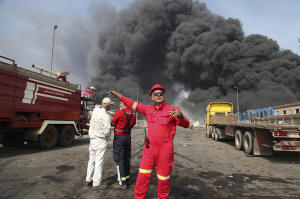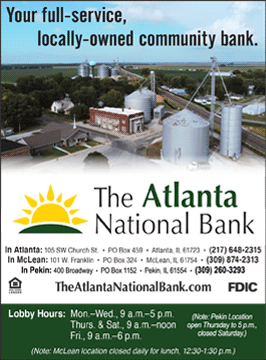The epicenter of an explosion at an Iranian port is tied to a charity
overseen by its supreme leader
[April 30, 2025]
By JON GAMBRELL
DUBAI, United Arab Emirates (AP) — The explosion that rocked an Iranian
port, killing at least 70 people and injuring more than 1,000 others,
had its epicenter at a facility ultimately owned by a charitable
foundation overseen by Supreme Leader Ayatollah Ali Khamenei's office.
That foundation, known as Bonyad Mostazafan, faces American sanctions
over it helping the 86-year-old Khamenei “to enrich his office, reward
his political allies and persecute the regime’s enemies,” the U.S.
Treasury has said. Its top personnel also have direct ties to Iran's
paramilitary Revolutionary Guard, which oversees Tehran's ballistic
missile arsenal and operations abroad targeting the Islamic Republic's
enemies.
Those associations come as authorities still haven't offered a cause for
the blast Saturday at the Shahid Rajaei port near Bandar Abbas. The port
reportedly took in a chemical component needed for solid fuel for
ballistic missiles — something denied by authorities though local
reports now increasingly point toward a mysterious, highly explosive
cargo being delivered there.
Bonyads hold vast economic power in Iran
A bonyad, the Farsi word for “foundation,” wields tremendous power in
Iran. The bonyads take their root in foundations set up by Shah Mohammad
Reza Pahlavi during his rule.
After the 1979 Islamic Revolution toppled the shah, Grand Ayatollah
Ruhollah Khomeini set up the bonyads to manage those assets, as well as
companies seized from supporters of the shah and religious minorities,
like the Baha’i and Jews.
Bonyad Mostazafan, or the “Foundation of the Oppressed,” is believed to
be the largest in the country by assets, with a 2008 U.S. Congressional
Research Service report suggesting it represented 10% of Iran's entire
gross domestic product at the time. The Treasury in 2020 put its worth
into the billions of dollars. Its network includes interests in mining,
railroads, energy, steel and shipping through its Sina Port and Marine
Services Development Co.

Satellite photos analyzed by The Associated Press show the epicenter of
Saturday's explosion struck just next to Sina's terminal at the port,
shredding the facility and the containers stacked nearby.
Late Sunday, Iran’s semiofficial ILNA news agency quoted Saeed Jafari,
the CEO of Sina, as saying there had been false statements about the
cargo that detonated, which he called “very dangerous.”
“The incident happened following a false statement about the dangerous
goods and delivering it without documents and tags,” Jafari said. He
didn't elaborate and access to the site has been restricted by
authorities since the blast.
Mostazafan has direct ties to the Guard, security forces
Since its creation, Bonyard Mostazafan has been linked to the Guard. Its
current president, Hossein Dehghan, reached the rank of general in the
Guard and serves as a military adviser to Khamenei. Other leaders in the
foundation's history have had direct and indirect ties back to the
Guard.
The U.S. Treasury separately describes the foundation as having business
relationships or cash transactions with the country's police, the
Defense Ministry and the Guard as well.
[to top of second column]
|

In this photo provided by Islamic Republic News Agency (IRNA)
firefighters work as black smoke rises in the sky after a massive
explosion rocked a port near the southern city of Bandar Abbas,
Iran, Saturday, April 26, 2025. (Mohammad Rasoul Moradi/IRNA via AP)

“Mostazafan has de-facto been functioning as the IRGC’s ‘money box,’
whereby its financial assets and resources are made available to senior
IRGC commanders, not least to fund terrorist activities,” alleges United
Against Nuclear Iran, a New York-based pressure group, using an acronym
for the Guard.
In sanctioning Bonyad Mostazafan in 2020, the first Trump administration
described the foundation as being used by Khamenei to “line the pockets
of his allies.”
“Despite its outsized influence in the Iranian economy, Bonyad
Mostazafan operates outside of government oversight and, due to a 1993
decree by the Supreme Leader, is exempt from paying taxes on its
multibillion-dollar earnings,” the U.S. Treasury said. The foundation
says its affiliated companies pay taxes.
US issues sanctions over China-to-Iran chemical shipments
On Tuesday, the Treasury issued new sanctions on China and Iran over the
transshipment of sodium perchlorate and dioctyl sebacate to the Islamic
Republic. Sodium perchlorate is used to produce ammonium perchlorate, a
key ingredient to make solid fuel for ballistic missiles. The Treasury
identified one individual from an Iranian firm as being linked to the
Guard.
The Financial Times in January first reported that two loads of sodium
perchlorate were coming to Iran from China. Tracking data showed that
one of the ships identified as carrying the load was near Shahid Rajaei
in recent weeks. The private security firm Ambrey separately said that
the port received the sodium perchlorate, which is described as a white,
sand-like solid.
Iranian Defense Ministry spokesperson Gen. Reza Talaeinik denied earlier
this week that missile fuel had been imported through the port. Iranian
Cabinet spokesperson Fatemeh Mohajerani separately described the
explosion Wednesday as coming from "human error, probably.”
However, no official in Iran has offered any explanation for what
material detonated with such incredible force at the site.
A reddish cloud could be seen in surveillance camera footage before the
blast Saturday. That suggests a chemical compound like ammonia being
involved in the blast, like the 2020 Beirut port explosion, in which
ammonium nitrate caught fire and exploded.
That cloud also resembled one seen in footage from a 1988 massive
explosion in Nevada at the PEPCON plant that killed two people and
injured hundreds. PEPCON, or the Pacific Engineering and Production
Company of Nevada, made rocket fuel for NASA and had accumulated
ammonium perchlorate that went unused after the Challenger disaster,
leading to the blast.
Similar reddish smoke could be seen just before a 2013 explosion at a
Texas fertilizer plant filled with ammonium nitrate that killed 15
people.
Separately, a health warning issued by authorities after the blast
warned the public that pollutants like ammonia, sulfur dioxide and
nitrogen dioxide likely were in the air.
All contents © copyright 2025 Associated Press. All rights reserved |